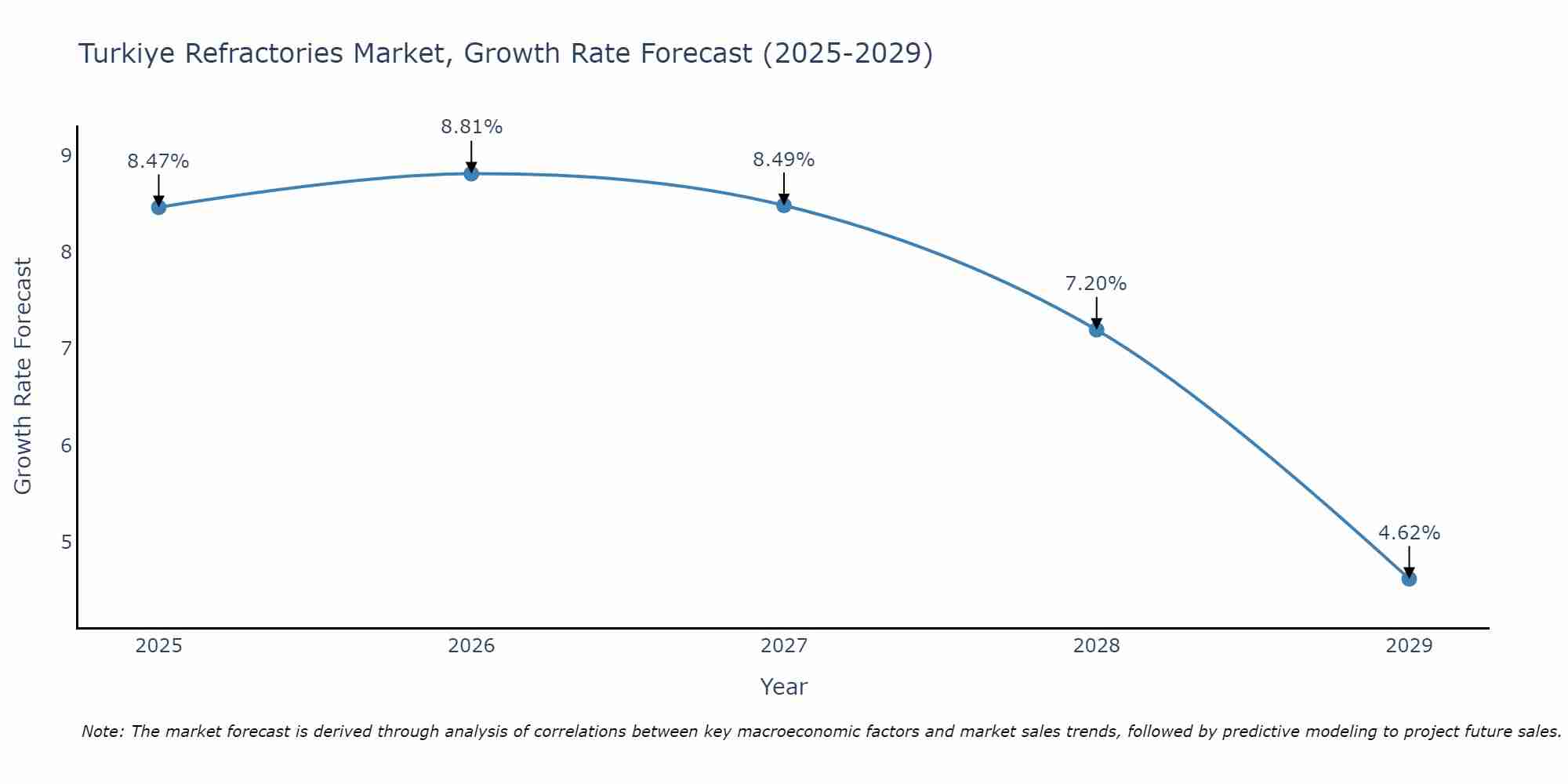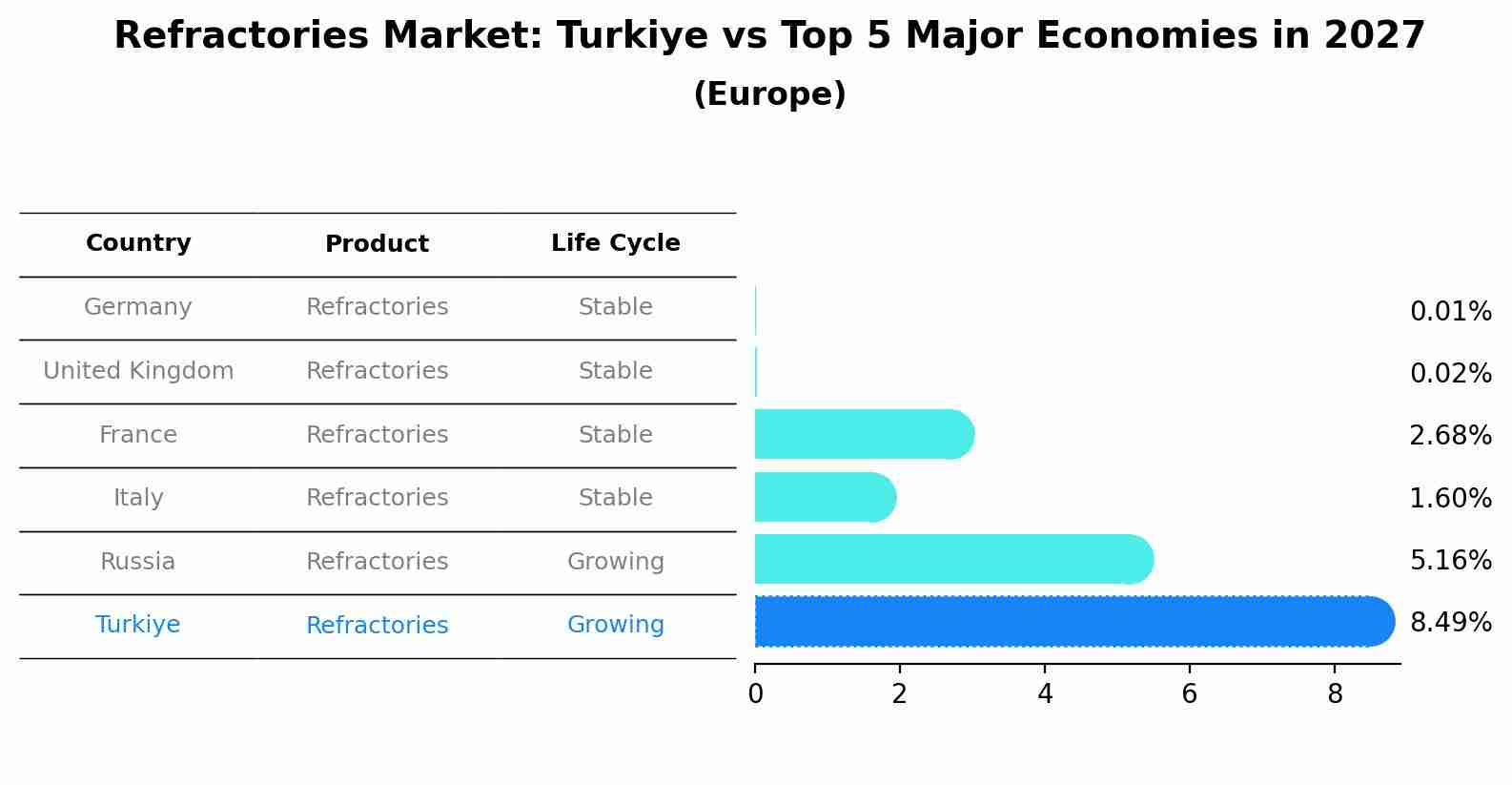Turkey Refractories Market (2020-2026) | Share, Value, Revenue, Forecast, COVID-19 IMPACT, Analysis, Outlook, Companies, Trends, Growth, Size & Industry
| Product Code: ETC008698 | Publication Date: Jun 2023 | Updated Date: Aug 2025 | Product Type: Report | |
| Publisher: 6Wresearch | Author: Ravi Bhandari | No. of Pages: 70 | No. of Figures: 35 | No. of Tables: 5 |
Turkiye Refractories Market Size Growth Rate
The Turkiye Refractories Market is projected to witness mixed growth rate patterns during 2025 to 2029. Starting at 8.47% in 2025, the market peaks at 8.81% in 2026, and settles at 4.62% by 2029.

Refractories Market: Turkiye vs Top 5 Major Economies in 2027 (Europe)
In the Europe region, the Refractories market in Turkiye is projected to expand at a growing growth rate of 8.49% by 2027. The largest economy is Germany, followed by United Kingdom, France, Italy and Russia.

turkey refractories market Synopsis
The Turkey refractories market s projected to register a CAGR of 5.4% during the forecast period (2020-2026). The increase in investments in steel production, growth of construction activities, implementation of stringent regulations regarding emission control are some factors driving the growth of the Turkey refractories market.
Steel industry is one of the major end use applications for refractory materials in Turkey due to its high capacity utilization rate over other industries such as iron & aluminum and cement manufacturing. Steel production was reported at 28 million metric tons per annum in 2017; thus making it an attractive destination for investment into this sector by various national & global players. Moreover, initiatives taken by Government towards environmental protection has further opened new avenues for Turkish steel producing companies seeking government subsidies and incentives that could help them meet their desired targets set under international standards with respect to emissions from their plants, which would also result into increased consumption of refractory products to meet these requirements over the forecast period (2020-2026).
Furthermore, rapid urbanization and increasing disposable income among consumers have led to rise in domestic demand for commercial and residential spaces globally including Turkey thus boosting growth prospects for construction sector across country which will further drive demand for fireproofing materials such as brick linings or ceramic fiber boards used extensively on walls & roofs subjecting them constantly exposed temperatures up to 1000?C which require quality insulation solutions provided by few manufacturers offering complete range of refractory products certified with international norms compliant with local standards making it a lucrative opportunity within potential customer segments leading towards higher sales channel revenues generated over forecasted time frame 2020-2026.
Key Highlights of the Report:
- Turkey Refractories Market Outlook
- Market Size of Turkey Refractories Market, 2019
- Forecast of Turkey Refractories Market, 2026
- Historical Data and Forecast of Turkey Refractories Revenues & Volume for the Period 2016 - 2026
- Turkey Refractories Market Trend Evolution
- Turkey Refractories Market Drivers and Challenges
- Turkey Refractories Price Trends
- Turkey Refractories Porter's Five Forces
- Turkey Refractories Industry Life Cycle
- Historical Data and Forecast of Turkey Refractories Market Revenues & Volume By Form Types for the Period 2016 - 2026
- Historical Data and Forecast of Turkey Refractories Market Revenues & Volume By Shaped Refractories for the Period 2016 - 2026
- Historical Data and Forecast of Turkey Refractories Market Revenues & Volume By Unshaped Refractories for the Period 2016 - 2026
- Historical Data and Forecast of Turkey Refractories Market Revenues & Volume By Product Types for the Period 2016 - 2026
- Historical Data and Forecast of Turkey Refractories Market Revenues & Volume By Non-clay Refractory for the Period 2016 - 2026
- Historical Data and Forecast of Turkey Refractories Market Revenues & Volume By Clay Refractory for the Period 2016 - 2026
- Historical Data and Forecast of Turkey Refractories Market Revenues & Volume By End-users for the Period 2016 - 2026
- Historical Data and Forecast of Turkey Refractories Market Revenues & Volume By Iron & Steel for the Period 2016 - 2026
- Historical Data and Forecast of Turkey Refractories Market Revenues & Volume By Cement for the Period 2016 - 2026
- Historical Data and Forecast of Turkey Refractories Market Revenues & Volume By Non-Ferrous Metals for the Period 2016 - 2026
- Historical Data and Forecast of Turkey Refractories Market Revenues & Volume By Glass for the Period 2016 - 2026
- Historical Data and Forecast of Turkey Refractories Market Revenues & Volume By Others for the Period 2016 - 2026
- Turkey Refractories Import Export Trade Statistics
- Market Opportunity Assessment By Form Types
- Market Opportunity Assessment By Product Types
- Market Opportunity Assessment By End-users
- Turkey Refractories Top Companies Market Share
- Turkey Refractories Competitive Benchmarking By Technical and Operational Parameters
- Turkey Refractories Company Profiles
- Turkey Refractories Key Strategic Recommendations
Frequently Asked Questions About the Market Study (FAQs):
1 Executive Summary |
2 Introduction |
2.1 Key Highlights of the Report |
2.2 Report Description |
2.3 Market Scope & Segmentation |
2.4 Research Methodology |
2.5 Assumptions |
3 Turkey Refractories Market Overview |
3.1 Turkey Country Macro Economic Indicators |
3.2 Turkey Refractories Market Revenues & Volume, 2019 & 2026F |
3.3 Turkey Refractories Market - Industry Life Cycle |
3.4 Turkey Refractories Market - Porter's Five Forces |
3.5 Turkey Refractories Market Revenues & Volume Share, By Form Types, 2019 & 2026F |
3.6 Turkey Refractories Market Revenues & Volume Share, By Product Types, 2019 & 2026F |
3.7 Turkey Refractories Market Revenues & Volume Share, By End-users, 2019 & 2026F |
4 Turkey Refractories Market Dynamics |
4.1 Impact Analysis |
4.2 Market Drivers |
4.2.1 Increasing demand from end-user industries such as steel, cement, and glass industries |
4.2.2 Growing infrastructure projects and construction activities in Turkey |
4.2.3 Advancements in technology leading to the development of high-performance refractory materials |
4.3 Market Restraints |
4.3.1 Fluctuating raw material prices impacting production costs |
4.3.2 Stringent environmental regulations affecting the manufacturing processes |
4.3.3 Intense competition from international refractories manufacturers |
5 Turkey Refractories Market Trends |
6 Turkey Refractories Market, By Types |
6.1 Turkey Refractories Market, By Form Types |
6.1.1 Overview and Analysis |
6.1.2 Turkey Refractories Market Revenues & Volume, By Form Types, 2016 - 2026F |
6.1.3 Turkey Refractories Market Revenues & Volume, By Shaped Refractories, 2016 - 2026F |
6.1.4 Turkey Refractories Market Revenues & Volume, By Unshaped Refractories, 2016 - 2026F |
6.2 Turkey Refractories Market, By Product Types |
6.2.1 Overview and Analysis |
6.2.2 Turkey Refractories Market Revenues & Volume, By Non-clay Refractory, 2016 - 2026F |
6.2.3 Turkey Refractories Market Revenues & Volume, By Clay Refractory, 2016 - 2026F |
6.3 Turkey Refractories Market, By End-users |
6.3.1 Overview and Analysis |
6.3.2 Turkey Refractories Market Revenues & Volume, By Iron & Steel, 2016 - 2026F |
6.3.3 Turkey Refractories Market Revenues & Volume, By Cement, 2016 - 2026F |
6.3.4 Turkey Refractories Market Revenues & Volume, By Non-Ferrous Metals, 2016 - 2026F |
6.3.5 Turkey Refractories Market Revenues & Volume, By Glass, 2016 - 2026F |
6.3.6 Turkey Refractories Market Revenues & Volume, By Others, 2016 - 2026F |
7 Turkey Refractories Market Import-Export Trade Statistics |
7.1 Turkey Refractories Market Export to Major Countries |
7.2 Turkey Refractories Market Imports from Major Countries |
8 Turkey Refractories Market Key Performance Indicators |
8.1 Research and development investment in innovative refractory products |
8.2 Adoption rate of advanced manufacturing processes in the refractories industry |
8.3 Number of strategic partnerships and collaborations with end-user industries for market expansion |
9 Turkey Refractories Market - Opportunity Assessment |
9.1 Turkey Refractories Market Opportunity Assessment, By Form Types, 2019 & 2026F |
9.2 Turkey Refractories Market Opportunity Assessment, By Product Types, 2019 & 2026F |
9.3 Turkey Refractories Market Opportunity Assessment, By End-users, 2019 & 2026F |
10 Turkey Refractories Market - Competitive Landscape |
10.1 Turkey Refractories Market Revenue Share, By Companies, 2019 |
10.2 Turkey Refractories Market Competitive Benchmarking, By Operating and Technical Parameters |
11 Company Profiles |
12 Recommendations |
13 Disclaimer |
- Single User License$ 1,995
- Department License$ 2,400
- Site License$ 3,120
- Global License$ 3,795
Search
Thought Leadership and Analyst Meet
Our Clients
Related Reports
- Germany Breakfast Food Market (2026-2032) | Industry, Share, Growth, Size, Companies, Value, Analysis, Revenue, Trends, Forecast & Outlook
- Australia Briquette Market (2025-2031) | Growth, Size, Revenue, Forecast, Analysis, Trends, Value, Share, Industry & Companies
- Vietnam System Integrator Market (2025-2031) | Size, Companies, Analysis, Industry, Value, Forecast, Growth, Trends, Revenue & Share
- ASEAN and Thailand Brain Health Supplements Market (2025-2031) | Strategy, Consumer Insights, Analysis, Investment Trends, Opportunities, Growth, Size, Share, Industry, Revenue, Segments, Value, Segmentation, Supply, Forecast, Restraints, Outlook, Competition, Drivers, Trends, Demand, Pricing Analysis, Competitive, Strategic Insights, Companies, Challenges
- ASEAN Bearings Market (2025-2031) | Strategy, Consumer Insights, Analysis, Investment Trends, Opportunities, Growth, Size, Share, Industry, Revenue, Segments, Value, Segmentation, Supply, Forecast, Restraints, Outlook, Competition, Drivers, Trends, Demand, Pricing Analysis, Competitive, Strategic Insights, Companies, Challenges
- Europe Flooring Market (2025-2031) | Outlook, Share, Industry, Trends, Forecast, Companies, Revenue, Size, Analysis, Growth & Value
- Saudi Arabia Manlift Market (2025-2031) | Outlook, Size, Growth, Trends, Companies, Industry, Revenue, Value, Share, Forecast & Analysis
- Uganda Excavator, Crane, and Wheel Loaders Market (2025-2031) | Strategy, Consumer Insights, Analysis, Investment Trends, Opportunities, Growth, Size, Share, Industry, Revenue, Segments, Value, Segmentation, Supply, Forecast, Restraints, Outlook, Competition, Drivers, Trends, Demand, Pricing Analysis, Competitive, Strategic Insights, Companies, Challenges
- Rwanda Excavator, Crane, and Wheel Loaders Market (2025-2031) | Strategy, Consumer Insights, Analysis, Investment Trends, Opportunities, Growth, Size, Share, Industry, Revenue, Segments, Value, Segmentation, Supply, Forecast, Restraints, Outlook, Competition, Drivers, Trends, Demand, Pricing Analysis, Competitive, Strategic Insights, Companies, Challenges
- Kenya Excavator, Crane, and Wheel Loaders Market (2025-2031) | Strategy, Consumer Insights, Analysis, Investment Trends, Opportunities, Growth, Size, Share, Industry, Revenue, Segments, Value, Segmentation, Supply, Forecast, Restraints, Outlook, Competition, Drivers, Trends, Demand, Pricing Analysis, Competitive, Strategic Insights, Companies, Challenges
Industry Events and Analyst Meet
Whitepaper
- Middle East & Africa Commercial Security Market Click here to view more.
- Middle East & Africa Fire Safety Systems & Equipment Market Click here to view more.
- GCC Drone Market Click here to view more.
- Middle East Lighting Fixture Market Click here to view more.
- GCC Physical & Perimeter Security Market Click here to view more.
6WResearch In News
- Doha a strategic location for EV manufacturing hub: IPA Qatar
- Demand for luxury TVs surging in the GCC, says Samsung
- Empowering Growth: The Thriving Journey of Bangladesh’s Cable Industry
- Demand for luxury TVs surging in the GCC, says Samsung
- Video call with a traditional healer? Once unthinkable, it’s now common in South Africa
- Intelligent Buildings To Smooth GCC’s Path To Net Zero


















